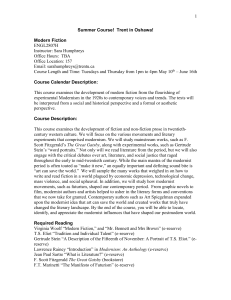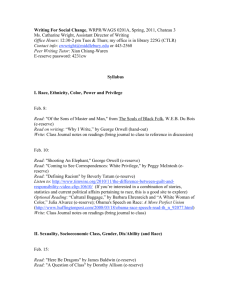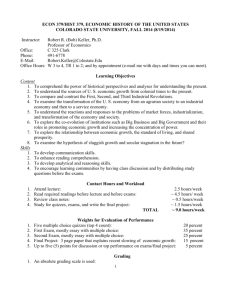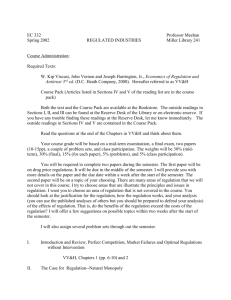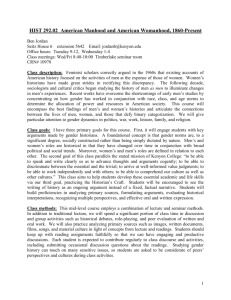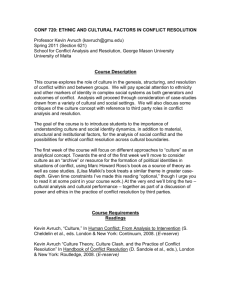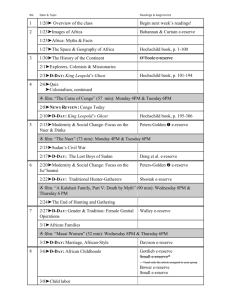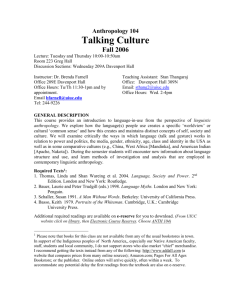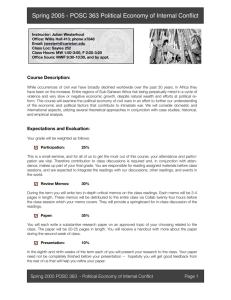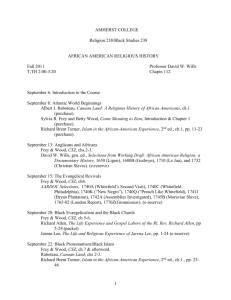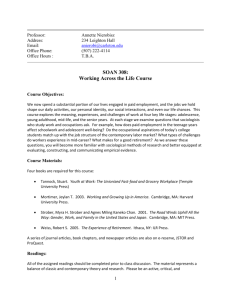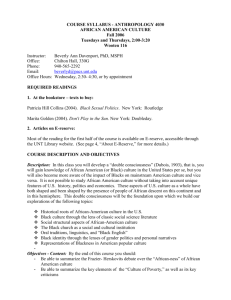Copyright Presentation_Final Rev 4-1-12 - Repositories
advertisement
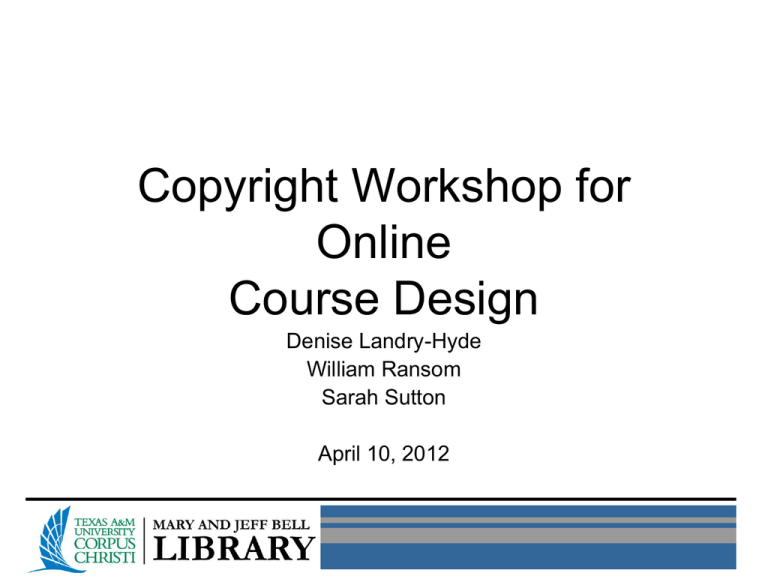
Copyright Workshop for Online Course Design Denise Landry-Hyde William Ransom Sarah Sutton April 10, 2012 Overview 1. Copyright Dos and Don’ts 2. Making copyrighted materials available to your students A. Electronic Reserves at the Library B. The Copyright Clearance Center C. More options 3. More information on copyright for online course design Copyright Dos and Don’ts • A good resource is the “Copyright Crash Course” by Georgia K. Harper, Scholarly Communications Advisor, University Libraries, University of Texas at Austin, © 2001, 2007. • “Copyright on Campus" from the Copyright Clearance Center. Copyright Dos and Don’ts • “Taking the Mystery Out of Copyright" from the Library of Congress is a good introductory tool, especially the “Reading the Fine Print” section. • Fair Use Checklist from Columbia University Libraries Copyright Advisory Office (Kenneth Crews) is a good fair use analysis document. Copyright Infringement Lawsuit against Georgia State University for copyright infringement, Cambridge University Press et al. v. Patton et al. First time a university has been sued for such violation. The trial phase began in May 2011. Electronic Reserves • Articles or book chapters placed on reserve and available online through the Bell Library webpage. • E-reserves are downloaded by each student in .pdf format and can be printed or saved to the student’s computer. • All e-reserves require copyright approval. Copyright Approval • The Bell library uses the Copyright Clearance Center (www.copyright.com) to purchase copyright approval for ereserves. • Price per item varies – Publishers – Number of pages – Number of students in course Annual Copyright License • The Bell Library purchases an Annual Copyright License through the CCC, under which certain publishers’ material can be utilized without additional charges. Copyright Approval Process • Approval for most items not covered by the Annual Copyright License can be purchased immediately. • Some purchases must be submitted as special orders through copyright.com, and take longer to be approved or denied. • Some publishers must be contacted directly for permission. Copyright Approval Process • The library can only obtain permission to post material on e-reserve from the institution which published the item and holds copyright. • The author is unable to provide copyright approval. • Not all publishers allow material to be placed on e-reserve. • Under no circumstances can material be placed on e-reserve without copyright approval. Copyright Approval Process • Some publishers place restrictions on items constituting too great a percentage of a larger work, the number of people able to access the item, or other criteria. • If a publisher has allowed copyright approval to be purchased in the past, there is no guarantee they will continue to do so. • Chapters from books or textbooks are often not granted permission. Copyright Approval Process • Although the Annual Copyright License covers the entire campus, copyright approval purchased for e-reserve items applies only to those items being placed on electronic reserve. • The library is unable to purchase or otherwise obtain copyright permission for items to be posted on WebCT, Blackboard, or used in any capacity other than electronic reserve. Copyright Approval Process • [Copyright purchase demonstration] E-Reserve Requests • E-reserve requests are submitted to the library in the same way as other reserve requests, such as print articles or textbooks; however, there are a few additional items necessary for e-reserve requests. • Requests can be submitted either through a reserve form or through an email with a list of requested items. E-Reserve Requests • A copy of each item being placed on ereserve must be submitted to the library. – Can be sent as a .pdf file or provided as a photocopy. • Professors should include the number of students in the class. • Professors should include citations for each item. E-Reserve Requests • The library will not be able to request copyright approval until copies of the material have been provided. • Because of staffing and time restrictions, the library is unable to obtain these copies; they must be provided by the professor. E-Reserve Requests • Length of time required for approval varies, but requests should be submitted at least seven days prior to the time the material will be needed for class. • Copyright approval is purchased for the entire semester, so earlier requests are always better. E-Reserve Requests • Each professor must submit separate ereserve requests. • One professor cannot submit a request for a different professor, even if the material is the same and they are teaching sections of the same course. E-Reserve Requests • Because of the cost and time requirements for copyright approval and ereserve processing, it is important that requests only be made for material which will definitely be used in the class, rather than for items which the professor may or may not decide to use. E-Reserve Requests • Because copyright approval is purchased on a semester-by-semester basis, all e-reserve items are removed at the end of every semester. • If the material will be needed again, a new reserve request must be submitted to the library. • However, if an item has been placed on ereserve before it is not necessary to submit a new copy of the item. Accessing E-Reserves • Once copyright approval has been purchased and an item has been placed on e-reserve, the library will notify the professor and provide the course password necessary to access the material. • The professor must give the course password to the students. • The library is unable to distribute course passwords to anyone but the appropriate professor. Accessing E-Reserves • Once the student has the password, they can go to the library’s webpage and search for reserve items by course number or professor’s name. • Within each course record is a list of all items on reserve for that course. • Upon clicking the title of an e-reserve item, the student will be asked to enter the course password, and the item will be opened as a .pdf file. E-Reserve Contact Information William Ransom Library Associate I 361.825.2815 william.ransom@tamucc.edu More options Embedding links to copyrighted library eresources into Blackboard. Benefit: Permissions for the use of materials in library databases and eresources by individuals have already been obtained by the database or e-resource vendor. Linking to Bell Library databases • Most library article resources are proprietary • Off campus users must identify themselves Example Example Prefix: https://manowar.tamucc.edu/login?url= Article link: http://search.proquest.com/docview/204980 327?accountid=7084 Example Embed the combined URL into your Blackboard course: https://manowar.tamucc.edu/login?url=http:// search.proquest.com/docview/204980327?a ccountid=7084 E-Resources Linking Contact Information Dr. Sarah Sutton Serials / Electronic Resources Librarian sarah.sutton@tamucc.edu 361.825.2355 The Law • Digital Millenium Copyright Act, DMCA (1998) updates the 1976 law. • TEACH Act (2002) eases restrictions somewhat for distance learning. • Individuals are liable for their own actions. Finding Free Images • BlackBoard has an agreement with YouTube, Flickr, and Slideshare by which materials from those sites may be used in BB without having to ask for permission • Images at Flickr with Creative Commons licenses • Google images that aren’t protected by copyright. Use Advanced Search and check for Usage Rights. • Credit your source, however. Finding Free Multimedia Materials, Digital Learning Objects Don’t reinvent the wheel Credit your sources • MERLOT, Multimedia Educational Resource for Learning and Online Teaching, California State University • ANTS, Animated Tutorial Sharing Project (Open Source Library Tutorials), COPPUL, Council of Prairie and Pacific University Libraries • TxLOR, Texas Learning Object Repository, in development by the Texas Digital Library • YouTube Finding Free Multimedia continued • Internet Archives, a digital library of free books, movies, and music • Library of Congress American Memory Project, free access to historical images, maps, etc. • NPR, National Public Radio, includes many podcasts Distance Learning Contact Information Denise Landry-Hyde Reference/Distributed Learning Librarian denise.hyde@tamucc.edu 361.825.2608 References California State University. (2011). MERLOT - Multimedia Educational Resource for Learning and Online Teaching. Retrieved April 1, 2012, from http://www.merlot.org/merlot/index.htm Copyright Clearance Center. (2011). Copyright Clearance Center | The Rights Licensing Experts. Retrieved April 1, 2012, from http://www.copyright.com/ Council of Prairie and Pacific University Libraries. (2008). Welcome to ANTS! - ANTS Animated Tutorial Sharing. Retrieved April 1, 2012, from http://ants.wetpaint.com/ Harper, G. (2001, 2007). Copyright Crash Course. Retrieved April 1, 2012, from http://copyright.lib.utexas.edu Harper, G. (2002). The TEACH Act. Copyright Crash Course. Retrieved April 1, 2012, from http://copyright.lib.utexas.edu/teachact.html References Justia. (2011). Cambridge University Press et al v. Patton et al: Justia Dockets & Filings. Retrieved April 1, 2012, from http://dockets.justia.com/do cket/georgia/gandce/1:2008cv01425/150651/ Kent State University. (2011, March 11). Copyright on the Internet: Interactive Quiz. Retrieved April 1, 2012, from http://literacy.kent.edu/Oasis/Workshops/copyquizinteractive.html Templeton, B. (2008). 10 Big Myths about copyright explained. Retrieved April 1, 2012, from http://www.templetons.com/brad/copymyths.html Texas Digital Library. (2009). Texas Digital Library. Retrieved April 1, 2012, from http://www.tdl.org/#feature1 Texas Higher Education Coordinating Board Distance Education Advisory Board. (2002, March 28). Guide for Incorporating the Principles of Good Practice into Electronically-Based Courses. References University of Calgary. (2006). DSpace at University of Calgary: Finding copyright free images on the Internet. Retrieved April 1, 2012, from https://dspace.ucalgary.ca/handle/1880/46634 University of Maryland University College. (2002). Welcome to ©Primer. Retrieved April 1, 2012, from http://www-apps.umuc.edu/primer/enter.php Washington State University. (2011). University Publishing: Copyright. Retrieved April 1, 2012, from http://publishing.wsu.edu/copyright/index.html 4/2012
